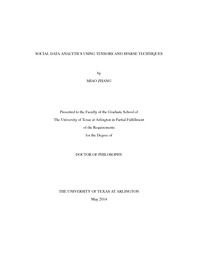
ATTENTION: The works hosted here are being migrated to a new repository that will consolidate resources, improve discoverability, and better show UTA's research impact on the global community. We will update authors as the migration progresses. Please see MavMatrix for more information.
Show simple item record
| dc.contributor.author | Zhang, Miao | en_US |
| dc.date.accessioned | 2014-07-14T20:21:21Z | |
| dc.date.available | 2014-07-14T20:21:21Z | |
| dc.date.issued | 2014-07-14 | |
| dc.date.submitted | January 2014 | en_US |
| dc.identifier.other | DISS-12619 | en_US |
| dc.identifier.uri | http://hdl.handle.net/10106/24393 | |
| dc.description.abstract | The development of internet and mobile technologies is driving an earthshaking social media revolution. They bring the internet world a huge amount of social media content, such as images, videos, comments, etc. Those massive media content and complicate social structures require the analytic expertise to transform those flood of information into actionable strategies, because mining those data can help organizations take control of those data, therefore organizations can improve customer satisfaction, identify patterns and trends, and make smarter marketing strategies. Mining those data can also help the consumers to grasp the most important and convenient information from the overwhelming data sea. By and large, there are three big constituents in social media content - users, resources/events and user's tags on those resources. In this thesis, we study three key technology areas to explore the social media data. The first is viral marketing (word of mouth) technology: we try to identify the most influential individuals on the social networks. We propose highly efficient and scalable methods to calculate the influence spread and then different greedy strategies will be applied to find the most influential users. Second, we live in a rich materialistic society: too many choices on everything. Recommender systems are the up-and-coming new information technology. Traditional recommender systems deal with users and items (books, movie, etc). New web 2.0 technology enables and encourages users to comment items (images) by assigning tags (key words). This social tagging recommendation helps new users (and existing users) to comment on more items with more tags -- assist the users to communicate with each other -- inciting more activities in the social network -- thus attracting more users! The tagging information also helps web sites to organize their resources. We propose to use lower-order tensor decomposition techniques to tackle the extremely sparse social network data. Last but not least, in the social tagging area, there are many types of social media objects, data and resources; and image is the most overwhelming part. Fast automatic analysis of vast number of images is mostly based on image annotation and segmentation. We propose an efficient and robust image reconstruction model by applying L1 norm sparse coding techniques in the collection of images (a tenor); this help significantly the annotation and segmentation analysis. We did extensive experiments on several real world data sets to evaluate our proposed models to the above three social network tasks, and experimental results demonstrate that our methods outperform state-of-the-art approaches consistently. | en_US |
| dc.description.sponsorship | Ding, Chris | en_US |
| dc.language.iso | en | en_US |
| dc.publisher | Computer Science & Engineering | en_US |
| dc.title | Social Data Analytics Using Tensors And Sparse Techniques | en_US |
| dc.type | Ph.D. | en_US |
| dc.contributor.committeeChair | Ding, Chris | en_US |
| dc.degree.department | Computer Science & Engineering | en_US |
| dc.degree.discipline | Computer Science & Engineering | en_US |
| dc.degree.grantor | University of Texas at Arlington | en_US |
| dc.degree.level | doctoral | en_US |
| dc.degree.name | Ph.D. | en_US |
Files in this item
- Name:
- Zhang_uta_2502D_12619.pdf
- Size:
- 1013.Kb
- Format:
- PDF
This item appears in the following Collection(s)
Show simple item record


